http://modernsmile.com/2010/10/ In a previous blog I wrote about the VMS cycles of life, the circles of nymphs that surround the zodiac symbols. This blog discusses why there are two zodiac symbols missing, why some of them are paired, and why some of the nymphs are clothed, something I was trying to work out when I wrote the original blog in April 2016.
Mi Casa
http://midequalitygroup.co.uk/events/2025-08-18/ The Spaniards are legendary for their hospitality. Mi Casa Es Su Casa is a common expression and I certainly received cheerful greetings everywhere I traveled in Mexico some years ago, even though I was a foreigner who knew nothing of the language. The locals immediately started teaching me Spanish and never frowned or rolled their eyes if I used the wrong word or pronounced it badly. Instead, they cheered my efforts and clapped me on the back for even the smallest effort.
In astrology, things are a little different. My house isn’t necessarily your house. The stars are in different positions every time a child is born, and their relative positions are said to reflect one’s destiny.
Most people are familiar with the zodiac, the twelve symbols that make up a cycle of constellations, but ask them about astrological houses and the majority have no idea what you are talking about.
In a nutshell, in medieval astrology, the heavens were divided into twelve parts, working from east to west and the houses are organized into groups of three, each group having its own general character (masculine, feminine, choleric, melancholic, etc.).
The Twelve Houses
The twelve houses are not the same as the twelve zodiac symbols—even though they are related. In astrological forecasting (horoscopes), the influence of the constellations and planets on a person’s life is based their positions at a specific time and place and this will depend on where they appear in relation to each other in various houses. In other words, a planet can show up in more than one house or not at all, and each planet, in turn, was said to govern specific zodiac symbols. It’s more about influence and the precise position of a constellation in the sky than sequence. A constellation can cross the boundary from one house to the next and thus be attributed to two houses.
The following simulations show the sky above Rome, Italy, courtesy of Fourmilab.ch. I thought this might make it easier to illustrate how the constellations move through successive houses. The red line is the ecliptic, which makes it easier to find the familiar zodiac constellations:
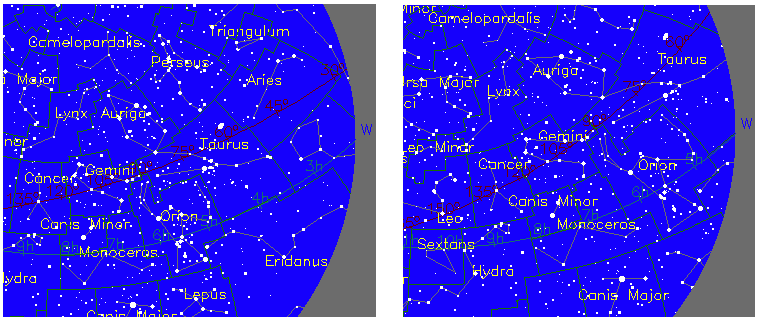 Note how Aries, Taurus, Gemini, and Cancer are related to one another in a curve from top right to middle left. In the second illustration, two hours later, Aries has moved outside our viewport, Taurus has moved close to where Aries was before, but Gemini and Cancer are still somewhat in the middle, a little farther apart (you have to remember that the Earth is round and our drawing is flat). Now imagine a grid with the twelve houses superimposed on this view of the sky and you can imagine how some of the constellations may have crossed a house boundary, some might be in the same house, and some might be in transition from one to the next. Thus, the position of the constellations in the houses is not as rigidly geometric as a zodiac wheel might imply.
Note how Aries, Taurus, Gemini, and Cancer are related to one another in a curve from top right to middle left. In the second illustration, two hours later, Aries has moved outside our viewport, Taurus has moved close to where Aries was before, but Gemini and Cancer are still somewhat in the middle, a little farther apart (you have to remember that the Earth is round and our drawing is flat). Now imagine a grid with the twelve houses superimposed on this view of the sky and you can imagine how some of the constellations may have crossed a house boundary, some might be in the same house, and some might be in transition from one to the next. Thus, the position of the constellations in the houses is not as rigidly geometric as a zodiac wheel might imply.
Medieval Houses in Brief
The houses are somewhat hierarchical and express cycles of human life. Astrologers have given specific significance to each house and those designations have evolved over the centuries, but here is how they were understood in the 11th to 15th centuries:
- The first house governs one’s life, soul, and general physical form.
- The second house relates to one’s household, property, business dealings, and relationships.
- The third house is kinship. It refers to one’s siblings, neighbors, communication, and local travels.
- The fourth house relates to one ancestors, assets, house and land, and local community.
- The fifth house is pregnancy and procreation, children and events in which people come together to celebrate and enjoy one another’s company. In modern astrology, it also relates more broadly to enjoyment and recreation.
- The sixth house refers to illness, calamity, and loss of property in the earlier manuscripts, and to living property, including servants, herd animals, and contractors in later manuscripts. In modern astrology, it relates to nurturance, health and well-being.
- The seventh house relates to marriage, matters of intimate relationships, partnerships, quarrels, lawsuits, agreements, and disputes.
- The eighth house relates to death and murder in earlier manuscripts, and to one’s estate, wills, inheritance, dowries, and other aspects of property in later manuscripts.
- The ninth house relates to journeys and long voyages, and also to philosophy, visions, and matters of religion.
- The tenth house relates to authority, including sultans, kings, dukes, judges, and generals, as well as one’s image and status in society. In modern astrology, it relates to status, career, and ambition.
- The eleventh house is friendship, trust, praise, and fidelity.
- The twelfth house relates to sorrow, enemies, debts, imprisonment, curses, secrets, and mischief. In modern astrology, it relates to clandestine activities, mysteries, privacy, and secrecy.
Medieval Horoscopes
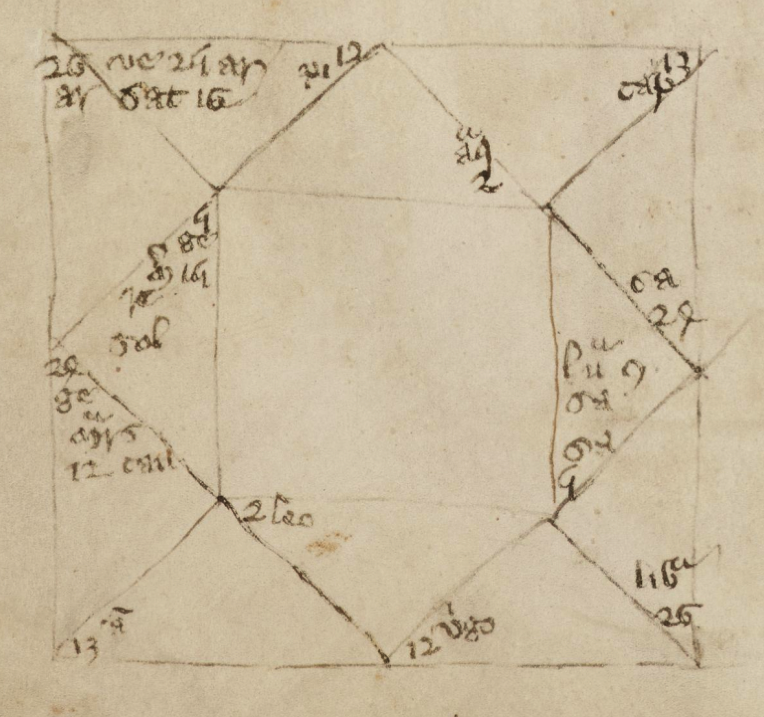
In the middle ages, the twelve houses were typically represented as twelve geometric divisions within a square. This form was still in use in the 17th century but was gradually superseded by the wheel-and-spokes style of chart. [Cambridge MS Peterhouse 75.I]
The positions of the planets are then added to each segment based on the time and location of the chart (volvelles were used to help calculate the positions), along with any constellations that have influence over that segment at the time. Specific planets and constellations do not always show up in every house or with equal frequency.
Astrology was a lucrative business. Manuscripts were hard to come by and those who owned books on astronomy that included charts for computing star positions could sell their skills to the nobility.
In a natal chart cast for King Henry VI in the 15th century (shown below), the sequence begins with Gemini in the first house, and Cancer in the 2nd and 3rd. Sagittarius is noted in the 7th house and Capricorn in both the 8th and the 9th, followed by Aquarius and Pisces in the 10th and 11th.
In other words, in a medieval chart, the sequence doesn’t necessarily start with Aries, as is typical of zodiac cycles, doesn’t necessarily include all the constellations, and sometimes repeats a constellation if the sign is in transition from one house to the next.
This method of plotting the positions of planets and stars might explain the peculiar arrangement of the VMS zodiac sequence. Imagine if you expanded out the twelve houses into twelve separate drawings rather than trying to fit them all into one grid.
To put it more simply, the VMS zodiac sequence might not represent a zodiac cycle, it might be an illustration of twelve houses and the sign that has the most influence within that house at the time and location for which the chart was cast.
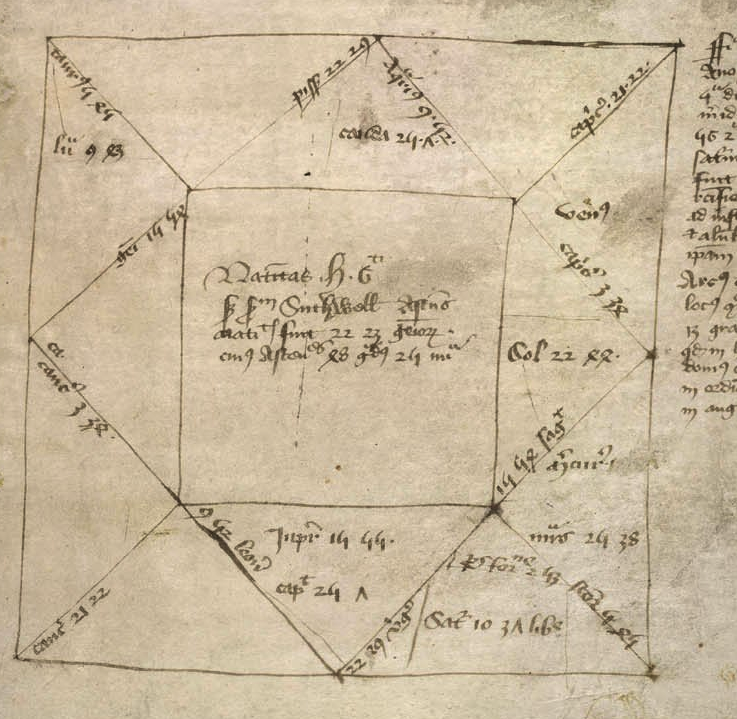
Medieval horoscopes are usually organized into geometric triangles within and surrounding a square. The name, date and time of birth (or of a specific event) are inserted into the central square. The houses usually begin in the triangle on the middle-left and follow twelve divisions counter-clockwise around the central square. This chart was drawn up for the birth of Henry VI (1421) in Cambridge, England. [Image credit: British Library, Eggerton 889]
Assigning Cycles to Houses
If the VMS zodiac folios represent an expanded natal (or other special-event) chart, it should be possible to identify the twelve houses by their subject matter.
The order of the houses doesn’t really matter. In less elaborate charts, they are identified by number, or simply by their position within a square as shown above. In the VMS, if the twelve wheels, taken together, represent a horoscope, it is a clever way to combine the meanings of the houses along with whichever constellation was visible in that house at that particular time—a two-in-one solution to schematic representation that makes it mnemonically easier to understand the houses.
Relating VMS Wheels to Traditional Houses
It’s not difficult to find commonalities between the VMS zodiac wheels and traditional descriptions of the astrological houses, but do they relate well if taken in sequence?
- First House—One’s life and physical form. The first VMS wheel appears to be a cycle of life, from birth to death as discussed here, so it matches quite well to the first house.
- Second House—Household and property. The second VMS wheel looks like a cycle of pregnancy to me, from childhood through puberty, to pregnancy and post-partum, which doesn’t seem to fit the second house’s relation to material goods and property.
- Third House—Kinship. The third VMS wheel has always looked like a medieval family tree to me, and the traditional third house relates to kinship and relations, so maybe this one matches.
- Fourth House—Ancestors and assets. Once again we have something that resembles a family tree and shows fancy clothing (material goods and assets). This relates well to the theme of ancestors and assets.
- Fifth House—Pregnancy and Procreation. I would have expected the second VMS wheel to be here, the one that looks like puberty > pregnancy > post-partum. The sixth VMS wheel would also be appropriate in this slot, as it has men and women together with the man’s genitals clearly drawn. Perhaps the fifth VMS fits, as it shows what appears to be a cycle of menstruation followed by a fat stomach (pregnancy?) followed by a more slender waistline, and there are men in this wheel, but I’m not completely sure.
- Sixth House—Illness and Calamity. The sixth VMS wheel has a high proportion of men and relates to romance and sex in both the inner circle (with the courting Gemini figures) and the images that surround it, so I can’t see any relationship here between the VMS figures and illness or calamity. The sixth wheel would fit better in the fifth house.
- Seventh House—Marriage. It’s difficult to see what is going on in this wheel because many of the figures are male but some of the male-like figures appear to have breasts added in darker ink in a style that is slightly different from the other female nymphs. It’s also difficult to know if this represents marriage when sex has already been shown in a couple of the previous wheels and there doesn’t appear to be as much sex going on here (some of my friends would probably joke that that is typical of marriage).
- Eighth House—Death and Murder. Death and murder is not a topic we frequently see in the VMS. Most of the nymphs are going about their business quite happily and the animals have paws instead of claws and never show any teeth, not even the one that vaguely resembles a lion. So, I’m not sure how to interpret the eighth VMS wheel other than to note that many of the nymphs appear pregnant.
- Ninth House—Journeys. What can I say, more nymphs, some of them heavily pregnant. It was mostly the men who went on long journeys… sailors, crusaders, soldiers, explorers, merchants, so it’s hard to know if this wheel relates at all to the ninth house.
- Tenth House—Authority. This is another wheel in which many of the figures look like they are male and where some of them look like they’ve had breasts added. A few have fancy head-dresses. It doesn’t overtly seem to represent authority unless it means medieval authority of men over women.
- Eleventh House—Friendship. The eleventh VMS wheel is a mixture of male and female nymphs (once again, some seem to have had breasts added) and there are four figures across the top with long hair, two with fancy headdresses. I can’t tell if this represents friendship. There’s nothing overtly indicating friendship other than the nymph top-right and the one middle-left (inner ring) who are touching the the nymphs beside them and this isn’t enough to know for sure.
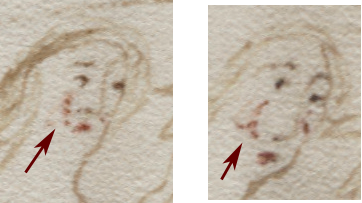 Twelfth House—Sorrow and enemies. Are these nymphs more sorrowful than others? Look at their mouths. Also, note that there are nymphs across the top of this one in the same manner as the previous wheel. If wheels 11 and 12 represent the yin and yang of friendship/trust and sorrow/enemies, they might conceivably be drawn in similar ways. Note how the nymph directly above the crossbowman has a line of red dots on her cheek, rather than the usual blotch of blush. One can sometimes find dots on the other nymphs, but not usually in a vertical line. I’m not sure if this is a sneaky way to represent tears or just an anomaly, so I’ll leave it to the reader to decide.
Twelfth House—Sorrow and enemies. Are these nymphs more sorrowful than others? Look at their mouths. Also, note that there are nymphs across the top of this one in the same manner as the previous wheel. If wheels 11 and 12 represent the yin and yang of friendship/trust and sorrow/enemies, they might conceivably be drawn in similar ways. Note how the nymph directly above the crossbowman has a line of red dots on her cheek, rather than the usual blotch of blush. One can sometimes find dots on the other nymphs, but not usually in a vertical line. I’m not sure if this is a sneaky way to represent tears or just an anomaly, so I’ll leave it to the reader to decide.
Implications
Many of the VMS wheels can be related to medieval astrological houses, and several appear to be in the right sequence, but is the similarity strong enough to support the idea? Let’s go back to the horoscope and see if there’s anything that can help confirm or deny this impression…
Looking at Henry VI’s chart, shown above, we see Gemini listed in the first house, Cancer in the second and third, “Leon9” (Leo), in the fourth, and so on, with Pissz (Pisces) in the 11th, and “Taur9” (Taurus) in the twelfth.
Thus, in King Henry’s chart, Gemini is first, Cancer and Capricorn are each represented twice and Aries and Libra are missing. Why is this? Because a natal chart is drawn up for a specific time and place. It doesn’t have to start with Aries, it starts with the person’s “birth sign” or ascending constellation. At the same time, some of the constellations may be transitioning from one house to the next, and others may not be expressly visible.
This is very similar to the way the VMS zodiac symbols are represented. The cycle begins with Pisces, not with Aries, and Aries and Taurus are shown twice, while Capricorn and Aquarius are not shown at all.
If the VMS zodiac-symbol sequence is a natal horoscope (or one for a specific event, like the investiture of a king), whose is it? Does it relate to the creator of the VMS or perhaps to a patron, or to one of the prominent individuals of the time? Or is it a teaching tool, to give an example of how a prognostication chart might be organized? Is it perhaps an example of “judicial astrology” in which a legal judgment for some infraction is said to be written in the stars?
Here is a simulation of the sky above Rome, Italy, at midnight on January 1st, 1408. Aries, Taurus, Gemini, Cancer, Leo, and Virgo are clearly visible and the others are outside our current point of view:
If we want to see how the sky might have appeared after Pisces came into view (for the same location) we have to look later in the year—around the end of November or beginning of December:
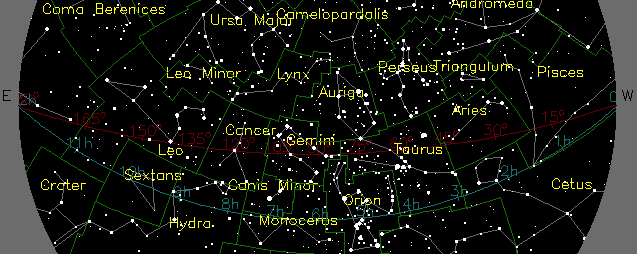 This, of course, will change as you go farther north or south (and east or west). For example, if you go south to Cairo, Egypt, and look up at the same time and date as the previous example, Pisces will not yet be visible.
This, of course, will change as you go farther north or south (and east or west). For example, if you go south to Cairo, Egypt, and look up at the same time and date as the previous example, Pisces will not yet be visible.
Summary
I’ve said this in the past, but wasn’t sure how to explain it in a blog before now, but I think the VMS sequence may be a horoscope, rather than a zodiac cycle or calendar. Many aspects that seem strange in the context of a zodiac cycle are not, if the entire sequence is viewed as the chart for a specific event. It would also be a credit to the VMS creator, if he or she found a unique way to pictorially combine the concepts of astrological houses with an “expanded” prognostication chart.
As a bonus, if the VMS zodiac series is a horoscope for a specific event (rather than a teaching example using arbitrary zodiacs) then, with a bit of computing power, it may be possible to calculate the specific times and places during which Pisces was rising, Aries and Taurus were on the boundary between houses, and Capricorn and Aquarius were not visible enough to be included.
Postscript [3 hours later]: I don’t know if I was clear enough about how I think the VMS wheels might relate to medieval horoscopes, such as the one cast for Henry VI, so I have expanded each of the sections of the Henry VI chart and added the influences of the houses, so they can be compared more easily to the VMS wheels. With the exception of the Gemini nymphs (which seems better matched to House 7 than House 6) and the 8th House (Death, Murder, Estate), the correspondence between the houses and the VMS figures is not too bad. You can click on the images to see them larger:
J.K. Petersen
© Copyright 2017 J.K. Petersen, All Rights Reserved. Citations: J.K. Petersen, 12 July 2017, voynichportal.com

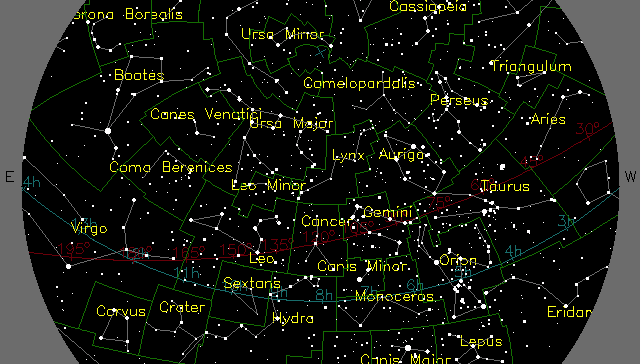
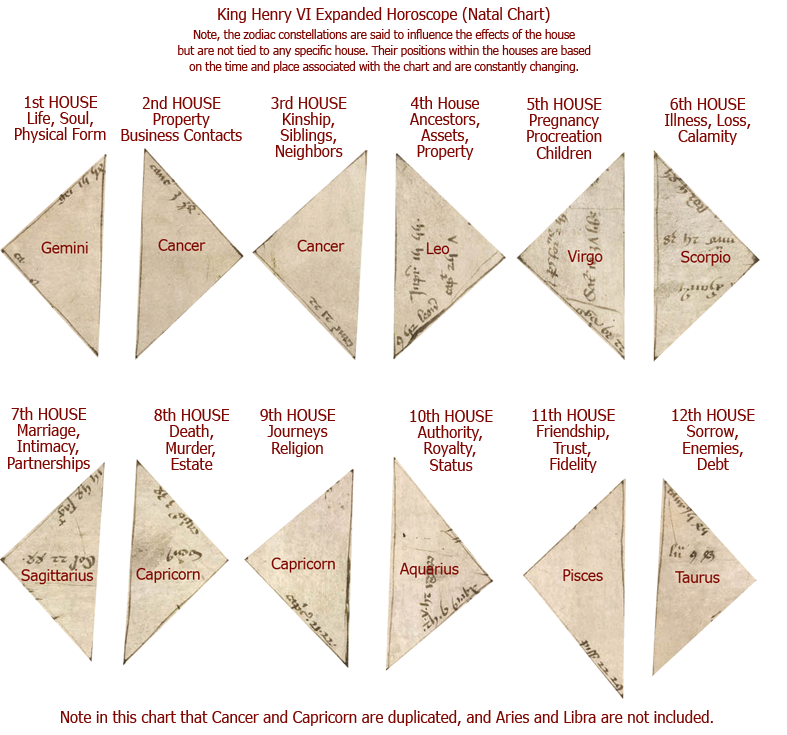
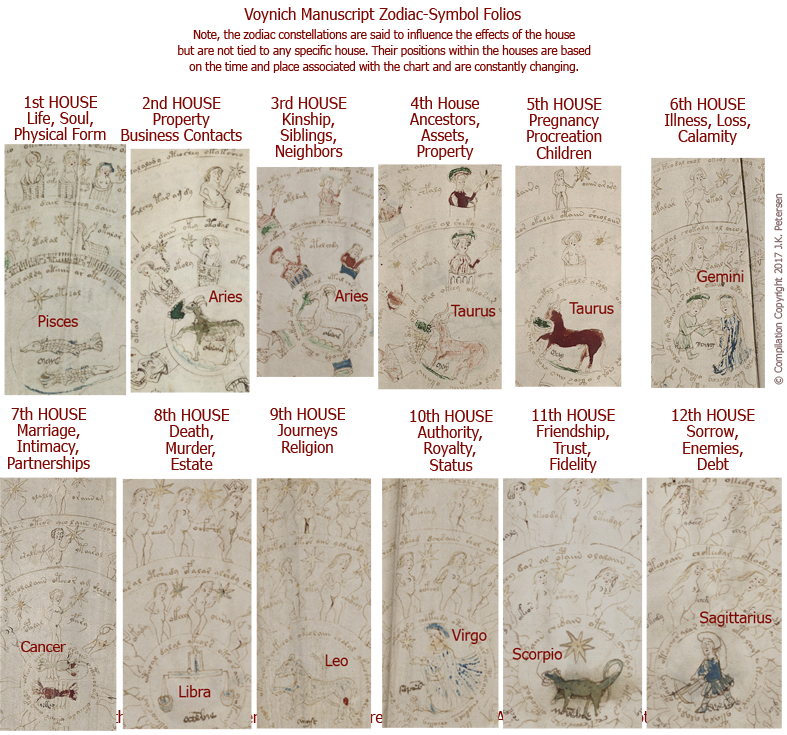
JKP mi amigo
I certainly like this approach, since it might explain a lot about the nymphs around the Zodiac images. I have no explanation yet for those which I find entirely satisfying, so I’m open to all possibilities still.
It’s certainly true that the nymphs in some circles have a certain character which differs from that of those in other circles. So I’d agree that we have to look for a (month, season or sign related) explanation for those.
Now I don’t know much about astroLOgy, and I’m still learning about astronomy, but…
If I understand it correctly, a horoscope is a snapshot of one exact moment, right? Aren’t there always at most six or seven (five and two partial) constellations of the ecliptic visible at any given moment? The horizon will always intersect the ecliptic at two points, always cutting it in half. I assume the same is true when one makes abstraction of the constellations and divides the ecliptic into twelve equal “signs”. I’d even expect the latter to result in even more exact six-or-seven counts.
I’m just saying, you can never have a moment when Pisces all the way through to Sagittarius is visible, even partially.
Something which also bothers me (because I don’t understand what it means) is the following. Imagine that you take all the rings of nymphs and turn them into a long string, in order. Then there would be a continuous, gradual progression. From clothed to unclothed, elaborate to simple, colorful to dreary, barreled to unbarreled, set low on the line towards set high on the line…..
So I would expect a gradual progression throughout the year, rather than one which changes completely each month.
Yes, you’re correct, a horoscope is a snapshot of one moment and only a few constellations are visible at any given time.
Depending on the latitude, one can usually only see about six or seven and yet there are typically more in medieval charts. I don’t think the charts are entirely based on what one can see (especially since we can’t see stars in the daytime), so I was wondering whether they begin with the one that is just about to come above the horizon (in modern astrology, I think they start with the ones that are behind the Earth).
If so, one would expect about eight or nine different symbols in each chart but even that isn’t enough, since both Henry VI’s chart and the VMS wheel-set include ten different symbols. I’m not an expert on astrology, so I can’t explain the discrepancy between those that are included and those that are omitted in relation to those that are on the relevant side of the Earth. I only know that the constellations appear in a variety of positions in the houses, depending on time and place, and that they are believed to influence how a specific house affects a person’s life.
As to there being a progression from one wheel to the next in the VMS. If each wheel represents one of the twelve houses, then the subject matter doesn’t have to be progressive. For example, in historic astrology, the eighth house represents death and murder, which one might expect at the end, but one finds it sandwiched between marriage and long journeys in both European and Arabic manuscripts. I think the theme of each house may come from the perceived characteristics of its ruling planet more than its proximity to the previous and following houses (I am not certain because the original logic goes back to the Babylonians, and I didn’t go into the ruling planets because I don’t see evidence of them in the VMS wheels, but it is one possibility).
What I mean with the gradual progression is that in the VM, properties from one page spill over in the next. This is the clearest in the barrels. In the first four (fish, goats and light bull) all nymphs are barreled. Next, dark bull, there is even a transition with the inner circle barreled and the outer circle walking. This suggests a gradual progression that breaks month boundaries.
In the system you propose, I would expect one roundel to be “unaware” of the properties of its neighbours, because it’s an entity with its own unique properties. This is not the case in the VM, where there is a gradual (seasonal?) progression from rich, complex, fancy towards simple, bland and dreary.
I don’t know if the astrological houses were intended to be completely stand-alone in the thematic sense. They start with “ego”, the self, and expand out into kinship, neighbors, and then to ancestors. The progression is not perfect, the 5th house, procreation and children, comes before marriage and partnerships (but that may have been common in pre-Christian days when pagan customs were more sexually liberal—if impregnated you got married). Short journeys and community come before long journeys. Business contacts come before authority/royalty/personal status. It might be easier to represent the relationships in a cloud diagram, but since they were constrained to a linear representation, it’s not an unreasonable way to encapsulate the journey through life, with only death/murder (8th house) seeming significantly out of place (in the middle rather than at the end).
The boundaries are not definite either, as least as far as the constellations are concerned. Medieval horoscopes sometimes repeat a zodiac sign in the following house because a constellation is composed of several stars and some of them might be in the next house while others remain in the previous.
I don’t know if the VMS wheels are intended to represent astrological houses, but if they do, then the oddities one sees when trying to interpret it as a zodiac cycle aren’t oddities at all—they are typical of a medieval horoscope—and the legions of nymphs surrounding the symbols may have an explanation, as well, if they are mnemonic examples of the influence of the house.
…or the last page is missing. 🙂
Yes, that’s possible, but I was trying to find an overall logic in the zodiac folios that would account for all their unusual features…
• That they start with Pisces instead of the more usual Aries,
• that the zodiac symbols are surrounded by a great many male and female nymphs, both clothed and unclothed, with a somewhat narrative nature,
• that two symbols are duplicated, which is not typical of zodiac cycles, and
• that two symbols are not included.
A missing page only accounts for the last.
If they are intended as mnemonic illustrations for each of the astrological houses in a medieval horoscope, which are usually represented as twelve sections with zodiac symbols written or drawn inside them, which often omit or duplicate some of the symbols, and which apply to specific aspects of the human life cycle, it could account for all the seemingly unusual characteristics.
Hi JKP and Koen,
the subject is rather complex and I am sure my understanding of it is only partial. I think that the first step in order to correctly analyze the two diagrams posted here is to remember that zodiac signs are very different from zodiac constellations. The two diagrams make no reference to constellations, but are focused on the zodiac. Discussing constellations in this context is misleading.
Astrological diagrams represent the point of the ecliptic rising on the horizon on the left and the opposite, descending, point of the ecliptic on the right. The upper part of the diagram corresponds to the visible sky, the lower part to the invisible sky, and the horizontal to the horizon.
This applies to both these ancient square diagrams and to more modern circular diagrams like this:
https://commons.wikimedia.org/wiki/File:Natal_Chart_–_Adam.svg
While simple models of the astrological houses exist in which each house is made to correspond to a single zodiac sign, usually more complex systems are used. This is clearly the case with the two diagrams posted by JKP.
Often, the idea is to have as the cusp (beginning) of the first house the point that is rising on the horizon and as the cusp of the 10th house the point that is at the South (Medium Coeli).
If I understand correctly, one problem is that not all signs take the same time to rise above the horizon:
https://en.wikipedia.org/wiki/Ascendant#Long_and_short_ascension
“Because the Earth’s axis is tilted relative to the ecliptic, the twelve signs do not take the same amount of time to cross the eastern horizon … In the northern hemisphere, the signs of Aquarius, Pisces, Aries, Taurus and Gemini take much less time than the theoretical two hours to cross the eastern horizon”. Since these signs are “fast” it can happen that no house cusp falls in one of them when they are ascending.
“The signs of Cancer, Leo, Virgo, Libra, Scorpio and Sagittarius take much longer than two hours to do so” these slow signs can sometimes have two house cusps when ascending.
The effect is that (as you can see in the modern chart linked above) the Medium Coeli is not perpendicular to the ascendant. It will be tilted towards the ascendant (left) if slow signs are ascending, or towards the descendant (right) if fast signs are ascending. The effect of this tilt is that distance between house boundaries is not a regular, fixed 30 degrees. Since zodiac signs are by definition regular, fixed 30 degrees, you can have signs with two cusps or signs with no cusp.
The house computation for houses 10,11,12 (between the ascendant and Medium Coeli) is applied symmetrically to houses 4,5 and 6. So, what happens is that OPPOSITE signs can have two house cusps, in this case, another couple of OPPOSITE signs will have no house cusp.
In the Cambridge MS Peterhouse example, house cusps are:
gemini, gemini, cancer, leo, virgo, libra, sagittarius, sagittarius, capricornus, aquarius, pisces, aries
The fast ascending Taurus sign is ascending and has no cusp
Taurus/Scorpio are opposite and have no house cusps
Gemini/Sagittarius are opposite and have two house cusps each
In Henry IV’s horoscope:
gemini,cancer,cancer,leo,virgo, scorpio, sagittarius, capricorn, capricorn, aquarius, pisces, taurus
The fast ascending Aries sign is ascending and has no cusp
Aries / Libra are opposite and have no cusp
Cancer/Capricorn are opposite and have two house cusps each
Even if there are several different systems for computing houses, the signs that have no cusps must be opposite, and the signs that have two cusps must be opposite. It can’t be like the VMS that has consecutive signs with hypothetical double cusps and consecutive signs with hypothetical no cusps.
Marco Ponzi wrote: “While simple models of the astrological houses exist in which each house is made to correspond to a single zodiac sign, usually more complex systems are used.”
You are correct about those models. They aren’t just simple models, they are incorrect ones. Unfortunately, those models show a misunderstanding of the difference between a “house”, a “ruling sign”, and the constellations passing through a house. I have seen many sites where the writer assumes that a house is only associated with one zodiac sign—they neglect to consider that houses are always moving, as the Earth turns, and form a viewport of the constellations (both zodiacal and non-zodiacal) that is constantly changing.
[example]… Even if there are several different systems for computing houses, the signs that have no cusps must be opposite, and the signs that have two cusps must be opposite. It can’t be like the VMS that has consecutive signs with hypothetical double cusps and consecutive signs with hypothetical no cusps.
This is a good example and a good point. Even though signs can be in consecutive houses, one would not expect duplication or omission in two sets of consecutive signs. If Aries is duplicated, then one would expect another to be Libra rather than Taurus, and if Capricorn were omitted, one would expect the missing mate to be Cancer rather than Aquarius.
I’ve been trying to find medieval beliefs and customs that might explain the pattern of zodiac symbols together with the figures in the VMS wheels. The sequence is not a typical zodiac sequence or a typical calendar. In some ways, the medieval concepts of houses and horoscopes come closer to explaining the oddities than many other explanations, but I’ll agree with you that the layout of the symbols does not precisely fit this idea, either. Still, I hope it might inspire some different ways of looking at it, in the hopes that an explanation can be found.
I would just like to add that Aries and Taurus have not really been duplicated, but rather have been cut into two halves.
This may have had a special meaning, but it may also just be dictated by the size of the parchment.
The later signs have been drawn much less carefully, and it could be that the composer(s) did not bother, was/were in a hurry, or similar considerations.
The start with the sign of Pisces is intentional, without any doubt.
What if you projected the same chart over France (Paris) rather than Northern Italy? Would the data conform or change meaningfully?
Just ruminating. Due to precession of the equinoxes, as of 2019, the first point of Aries is actually well inside Pisces and it has been moving 1degree west every 72 years. It is too late at night to do the math, but considering the first point of Aries was defined by Hipparchus in 130 BCE, maybe by the time of the VMS the first point of Aries was already more in Pisces than in Aries?
It was indeed already well into Pisces by the early 1400s, it pretty much started around the birth of Christ, and remains so, we are working our way toward the Age of Aquarius. I think that is what is portrayed, ages of approximately 2150 years each, being parts of Plato’s great year, although as you mention it was Hipparchus who discovered precession. The clothing and barrels represent various culture and architecture, and moves backward in time toward more nomadic societies. How deep they are placed is analogous to how long the societies have stayed in one place. It is similar for quire 13. Note that by Gemini, or over 6000 years back in time, there is no further architecture to be had, except as ruins, knocked over, or piles of rubble. Ie this architecture is only found through archeology, or representative of caves. Note that the Pisces architecture are also knocked over and coloured green, i take this as a premonition of flooding to come. I think Capricorn and Aquarius are missing. Aries and Taurus are spread out because there is most known about these time periods.
After watching YouTube, I’ve been looking at these for a while and found your blog.
It seems we agree Capricorn and Aquarius are missing, and Aries and Taurus have two drawings each. So you’re trying to match 12 houses against only 10 signs?
I note that with the exceptions of Pisces (which has 29 nymphs – could the artist have miscounted?) and Leo (which I can’t confirm as the left side of the drawing is obscured but I believe has 30 nymphs), all the signs have 30 nymphs with Aries and Taurus having 15 on each drawing.
So it would seem to indicate a 360 day calendar with 30 days in each month / house … I was wondering if there was a connection to the Vedic calendar? It would be nice if we had Capricorn and Aquarius to confirm this, but c’est la vie.
There’s also the issue that while most drawings have 2 concentric circles of nymphs, some have 3.
CAPRICORN MISSING ???
AQUARIUS MISSING ???
PISCES 10 inner 19 outer (should this be 20?)
ARIES HALF ? 5 inner 10 outer
ARIES HALF ? 5 inner 10 outer
TAURUS HALF ? 5 inner 10 outer
TAURUS HALF ? 5 inner 10 outer
GEMINI 9 inner 16 outer 5 extra
CANCER 7 inner 11 outer 12 extra
LEO 12 inner 18 outer???
VIRGO 12 inner 18 outer
LIBRA 10 inner 20 outer
SCORPIO 10 inner 16 outer 4 extra
SAGITTARIUS 10 inner 16 outer 4 extra
I wonder if this has significance with certain religious holy days / pagan festivals ?
Anyway, some food for thought.